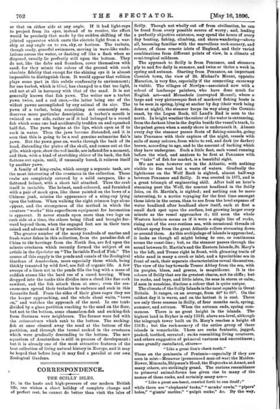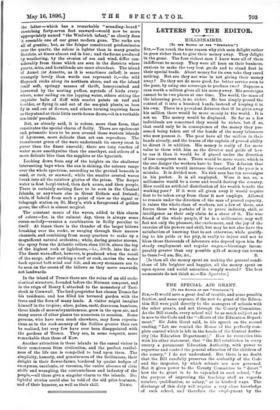CORRESPONDENCE.
THE SCILLY ISLES.
IF, in the haste and high-pressure of our modern British life, one wishes a short holiday of complete change and of perfect rest, he cannot do better than visit the isles of Scilly. Though not wholly cut off from civilisation, he can be freed from every possible source of worry ; and, leading a perfectly objective existence, may spend the hours of every day boating, fishing, climbing, and shore-wandering—above all, becoming familiar with the marvellous rock-scenery, and colour, of these remote islets of England, and their varied combinations from different points of view, in a climate of semi-tropical mildness.
The approach to Scilly is from Penzance, and steamers• ply to and fro daily in summer, and twice or thrice a week in spring and autumn. Starting from Penzance, an important; Cornish town, the view of St. Michael's Mount, opposite Marazion, is very fine, especially if the connecting causeway is visible. The villages of Newlyn—associated now with a school of landscape painters, who have done much for English art—and Mousehole (corrupted Mouzel), where s•. large and very picturesque fleet of mackerel fishing boats ia to be seen in spring, lying at anchor by day (their work being done at night), the steamer keeps its way along the Cornish, coast, by the Logan Rock, till Land's End is seen to the north. In bright weather the colour of the water is entrancing, from the darkest blue in the depths beside the vessel's track, to. the palest green when a sandy shore is underneath it. Almosh every day the steamer passes fleets of fishing-smacks, going; into Penzance with their capture of the night, vessels with sails of many colours, from white to red, and dark (or darker) brown, according to age, and to the amount of barking which they have undergone. Such a little fleet, each vessel running before the wind, and anxious to be first at Penzance with. its "take" of fish for market, is a beautiful sight.
We are soon however out in the Atlantic, with nothing• visible to the west but a waste of waters. Gradually the- lighthouse on the Wolf Rock is sighted, almost half-way between Penzance and Scilly. It was erected in 1871, and is a great triumph of engineering skill. After half an hour's. steaming past the Wolf, the nearest headland in the Scilly Isles, on St. Martin's, is sighted; and nothing can be more interesting, to a novice voyaging for the first time amongst these islets in the ocean, than to see from the level expanse of water headland after headland show itself, each at first a small dark spot upon the surface, but growing larger every minute as the vessel approaches it; till soon the whole Western horizon seems as if it were a single line of rocks, rising out of the ever-restless sea, with occasional threads of whitest spray from the great Atlantic rollers streaming down, or around them. As this archipelago of islands is approached,. it looks as though all might belong to one, so continuous seems the coast-line ; but, as the steamer passes through the sound between St. Martin's and the Eastern Islands, St. Mary's to the left, and Tresco right in front, with gleaming trails of white sand in many a creek or inlet, and a hyacinthine sea in. front of each, their separate characteristics reveal themselves- The view of the bay towards Tresco Abbey from the sea, with its purples, blues, and greens, is magnificent. It is the- colours of Scilly that are its greatest charm, not its cliffs ; but its rocks, and bays, and little islets, its seas in storm or calm,. if seen in sunshine, disclose a colour that is quite unique.
The climate of the Scilly Islands is the most equable in Great Britain. It ranges, on an average, from 40° to 60°. On the coldest day it is warm, and on the hottest it is cool. There are only three seasons in Scilly, of four months each, spring, summer, and autumn. When the autumn ends, spring com- mences. There is no great height in the islands. The highest land in Bryher is only 133 ft. above sea-level, although the telegraph tower built on St. Mary's reaches a height oft 158 ft.; but the rock-scenery of the entire group of these islands is remarkable. here are rocks fantastic, jagged, peaked, toothed, serrated ; mike resembling living creatures, and others suggestive of primeval vastness and uncouthness;, some grandly castellated, others- " Like a great lion's cheek-teeth."
Those on the peninsula of Peninnis—especially if they are seen in mist—Menawar (pronounced man-of-war) the Maiden- Bower, Mincarlo, Shipman's Head, the Haycocks at Annet, and many others, are strikingly grand. The curious resemblance to primeval animal-forms has given rise to many of the names of these rocks, and certainly many are- " Like a great sea-beast, crawled forth to sun itself ; "
while there are "elephants' tusks," "monks' cowls," "pipers' holes," "giants' castles," "pulpit rocks," &c. By the way, the latter—which has a remarkable " sounding-board " stretching forty-seven feet seaward—would now be more "the the Woolwich infant," so closely does appropriately named
it resemble one of our great modern guns. The rocks are X11 of granite; but, as the felspar constituent predominates over the quartz, the colour is lighter than in many granite districts, at times almost red in hue; and the forms produced by weathering, by the erosion of sea and wind, differ con- siderably from those which are seen in the districts where guartz, mica, and hornblende are more abundant. The island of Annet (or Annette, as it is sometimes called) is more -strangely lovely than words can represent it,—the wild Haycock rocks along its northern shore, and on the island itself soft, springy masses of thrift, honeycombed and burrowed by the nesting puffins, myriads of birds every- where, some sailing on the lapping water, others sitting like exquisite balls of fluff with scarlet points on reef and boulder, or flying in and out of the sea-pink plants, as bees fly in and out of flowers, and others turning inquiring faces as they stand at their little earth-house doors,—it is a veritable sea-birds' paradise.
But, as already said, it is colour, more than form, that constitutes the special charm of Scilly. There are opalescent and prismatic hues to be seen around those western islands of Lyonesse, more delicate than art can reproduce. The translucent green of the wave underneath its snowy crest is purer than the finest emerald; there are long reaches of water more amethystine than the amethyst, and others of a more delicate blue than the sapphire or the hyacinth.
Looking down from any of the heights on the shallower intersecting bays when the sun is shining, the colours range over the whole spectrum, according as the ground beneath is sand, or rock, or seaweed; while the smaller created waves break into all the rainbow glories of the prism. The deeper water is first beryl-tinted, then dark azure, and then purple. There is certainly nothing finer to be seen in the Channel Islands, or anywhere else in Great Britain and Ireland ; while, if beheld from such a point of view as the signal or telegraph station on St. Mary's, with a foreground of golden gorse, the effect is almost magical.
The constant music of the waves, added to this charm of colour—for, in the calmest day, there is always some ocean-melody—creates a combination in Scilly peculiar to itself. At times there is the thunder of the larger billows breaking over the rocks, or surging through their narrow channels, and combining from many quarters to make up a magnificent natural orchestra ; while, during greater storms, the spray from the Atlantic rollers rises 150 ft. above the top of the highest rock or lighthouse,—i.e., 300 ft. into the air. The finest wave-effect, however, is produced when the recoil of the surge, after striking a reef or rock, carries the water back against both wind and tide, and snowy streamers are to be seen on the crests of the billows as they move seawards, not landwards.
In the island of Tresco there are the ruins of an old eccle- siastical structure, founded before the Norman conquest, and in the reign of Henry L attached to the monastery of Tavi- stock in Cornwall. The lord-proprietor has chosen Tresco for his residence, and has filled his terraced garden with the trees and the flora of many lands. A. visitor might imagine himself in the tropics ; aloes, palms, cacti, dracamas, bamboos, three kinds of mesembryanthemum, grow in the open air, and many scores of other plants too numerous to mention. Some persons, who have seen much elsewhere, may form expecta- tions as to the rock-scenery of the Scillies greater than can be realised, but very few have ever been disappointed with the gardens of Tresco. They are, in some respects, more remarkable than those of Kew.
Another attraction in these islands to the casual visitor is their remoteness from civilisation, and the perfect restful- ness of the life one is compelled to lead upon them. The simplicity, honesty, and genuineness of the Scillonians, their delight in their flower-farms, bordered by quaint hedges of euonymua, esculonia, or veronica, the entire absence of civic strife and wrangling, the contentedness and industry of the people,—all these give a singular charm to the islands. De- lightful stories could also be told of the old pilot-boatmen, and of their humour, as well as their skilL Nzsto.







































 Previous page
Previous page